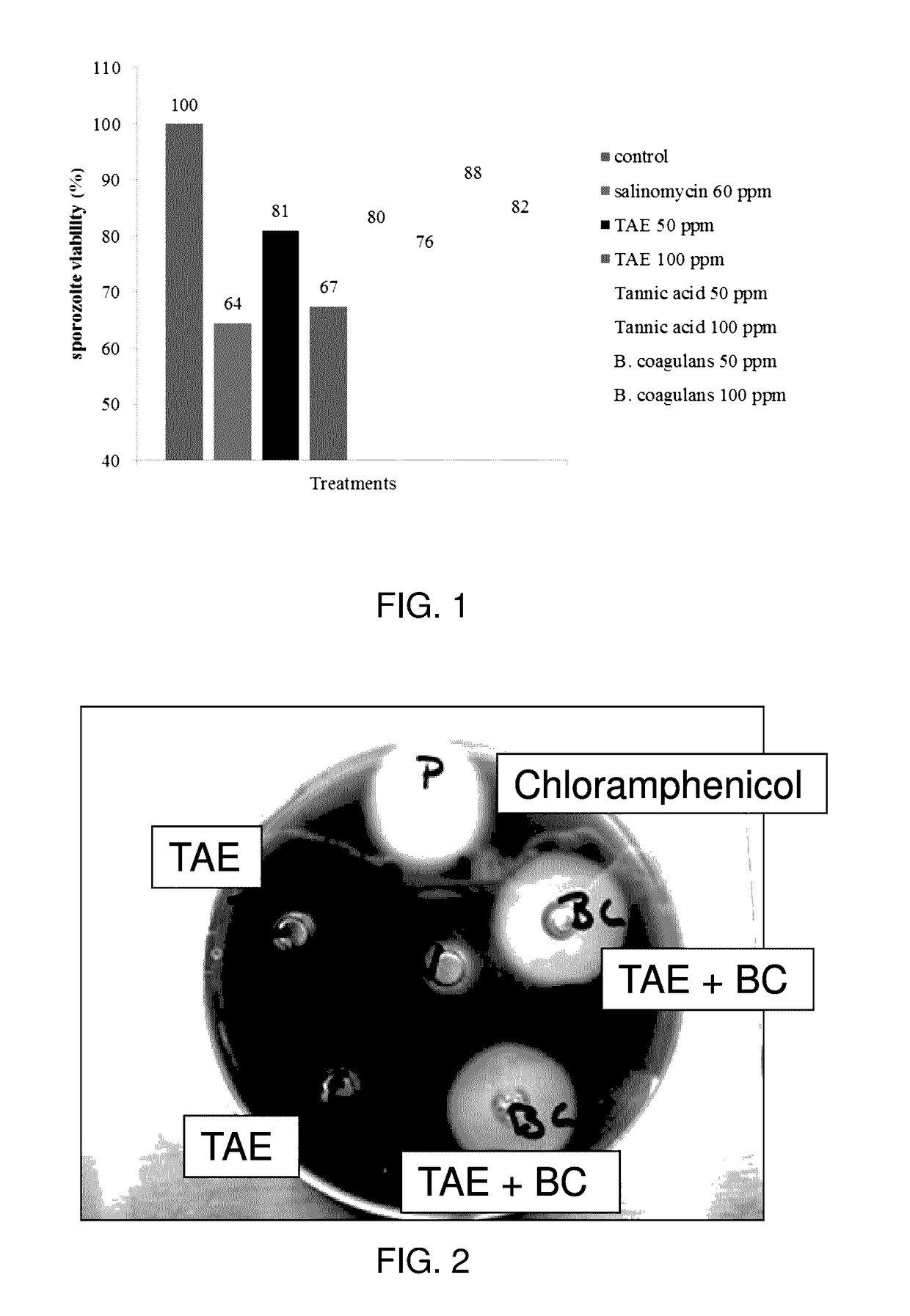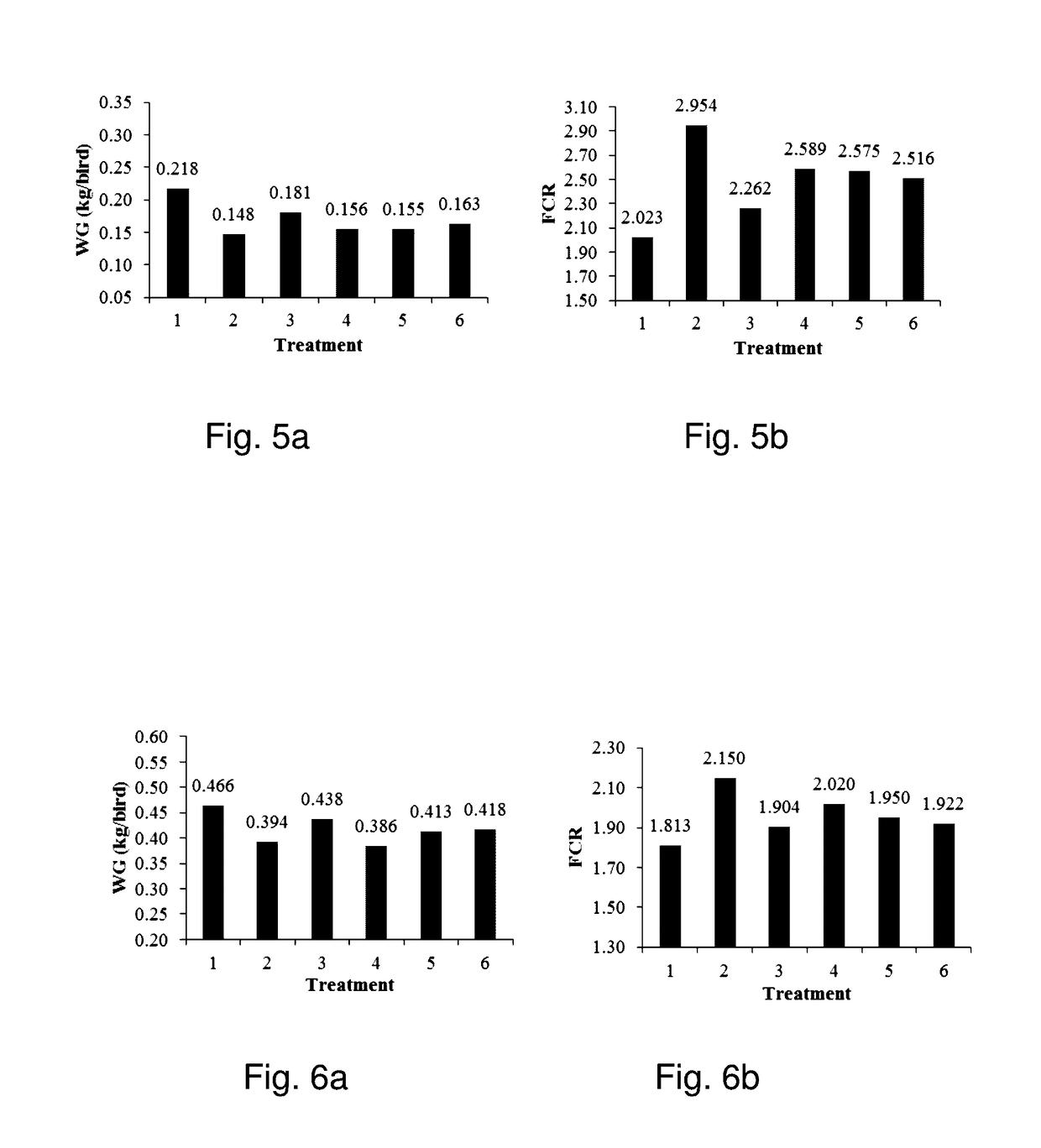Compositions and methods of improving performance and intestinal health of poultry
a technology applied in the field of compositions and methods of improving performance and intestinal health of poultry, can solve the problems of increased diarrhea, increased weight gain, and increased diarrhea, and achieve the effects of improving the performance of poultry challenged, improving the conversion of broiler feed, and increasing weight gain
- Summary
- Abstract
- Description
- Claims
- Application Information
AI Technical Summary
Benefits of technology
Problems solved by technology
Method used
Image
Examples
example 1
Viability of Eimeria Sporozoites In Vitro with Tannic Acid Extract and Bacillus coagulans
[0028]An in vitro MTT assay was conducted to measure the effects of tannic acid extract, tannic acid, and Bacillus coagulans on the viability of Eimeria tenella sporozoites. Sporozoites were released from sporulated oocysts by the method described by Dulski et al. (Dulski, P., et al., The purification of sporocysts and sporozoites from Eimeria tanella oocysts using percoll density gradients; Avian Diseases, American Association of Avian Pathologists, Kennet Square, Pa., USA, vol. 32, no. 2, 1988). The sporozoites were sterilized, followed by incubation of the sporozoite suspension (minimum of 105cells / mL) with 100 μL of tannic acid extract or 50 μL of B. coagulans cell free supernatant. This is followed by incubation of a MTT-PMS solution (0.2 millimolar each) with the sporozoite suspension (at 1:10 ratio) for 2 h at 41° C. After incubation, the contents were centrifuged at 800×g for 5 min and ...
example 2
Growth of Clostridium perfringens with Tannic Acid Extract and Bacillus coagulans In Vitro
[0030]An in vitro well diffusion assay was conducted to measure the ability of tannic acid extract and Bacillus coagulans to reduce the growth of C. perfringens. One gram of tannic acid extract or 1 g of tannic acid extract with B. coagulans concentrate (1×108 spores) was dissolved with 9 mL of saline solution. The samples were vortexed, then each sample was diluted 1 / 10 in saline. The diluted samples were heat treated at 80° C. for 10 min then were placed in cold water and allowed to cool for 5 min. A 1 mL aliquot of the 1 / 10 dilution samples was added to 99 mL of Tryptic Soy Broth and placed in a shaking incubator at 37° C. for 24 hours. The cell free supernatants were prepared by centrifugation of the cultures at 5000×g for 10 min. Following centrifugation, the supernatants were filtered through 0.22μ filters. For the well diffusion assay, the Clostridium cultures were prepared by inoculatin...
example 3
tudy of Tannic Acid Extract and Bacillus coagulans in Coccidiosis-Vaccinated Broilers
[0032]A 49-day trial with 3,000 Cobb×Cobb 500 male broiler chicks was conducted to investigate the effects of feed containing tannic acid extract and Bacillus coagulans on the performance and gut health of coccidiosis vaccinated broilers and vaccinated broilers challenged with a secondary Eimeria infection.
[0033]Day of hatch Cobb×Cobb 500 strain broiler chicks were obtained from Cobb-Vantress, Cleveland, Ga., USA. On day of hatch, prior to placement, all chicks were spray vaccinated with Advent®, a live coccidiosis vaccine, with the label recommended dosage via a Spraycox® machine. The Advent vaccine contains sporulated oocysts of E. acervulina, E. maxima, and E. tenella. To improve vaccine uptake, the chicks were allowed to preen for one hour prior to placement. Healthy appearing chicks were randomly selected from chick boxes and placed into 75 floor pens each containing 40 broiler chickens. Treatm...
PUM
 Login to View More
Login to View More Abstract
Description
Claims
Application Information
 Login to View More
Login to View More - R&D
- Intellectual Property
- Life Sciences
- Materials
- Tech Scout
- Unparalleled Data Quality
- Higher Quality Content
- 60% Fewer Hallucinations
Browse by: Latest US Patents, China's latest patents, Technical Efficacy Thesaurus, Application Domain, Technology Topic, Popular Technical Reports.
© 2025 PatSnap. All rights reserved.Legal|Privacy policy|Modern Slavery Act Transparency Statement|Sitemap|About US| Contact US: help@patsnap.com



